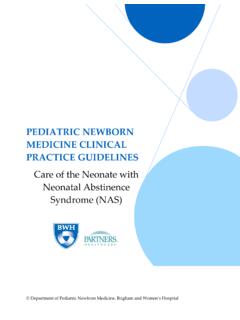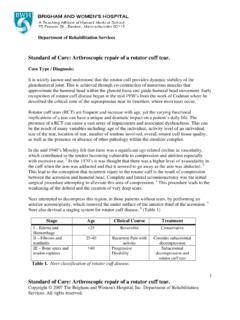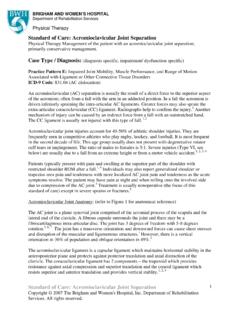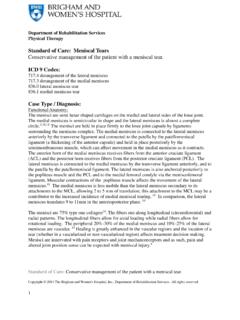Transcription of Standard of Care: Lower Extremity Amputation
1 BRIGHAM AND WOMEN'S HOSPITAL. Department of Rehabilitation Services Physical Therapy Standard of care : Lower Extremity Amputation The following is an outline of this Standard of care . You may use the hyperlinked text to advance to specific sections within the document. Types of Lower Extremity Amputation and Considerations Stages of Amputee Rehabilitation Contraindications, Precautions, and Considerations for Treatment Early Post-operative Complications Contractures Phantom Limb Pain and Sensation Pain Complications Functional Outcomes Post-operative Mortality Inpatient Acute Rehab for Patients with Pre-existing LE amputations Evaluation (Medical Record/Patient Interview and Physical Examination).
2 Assessment Goals Prognosis Interventions Therapeutic exercise program Positioning Guidelines for Edema Management and Prevention of Contractures Dressings Limb Shaping Mobility and Gait Training Skin-desensitization program Pain Management strategies Phantom Limb Pain and Sensation Management Coordination, Communication and Documentation Patient/Family Education Discharge Planning Prosthetic Prescription and Use Appendix I: LE amputee Exercise Program Appendix II: Limb Wrapping Techniques Appendix III: Online amputee support groups and resources Appendix IV: Amputee Mobility Predictor scoring: Definitions for the MFCL Classification Appendix V: Amputee Mobility Predictor (AMP) scoring form Appendix VI: Amputee Mobility Predictor (AMP) Testing Protocol Standard of care : Lower Extremity Amputation 1.
3 Copyright 2011 The Brigham and Women's Hospital, Inc., Department of Rehabilitation Services. All Rights Reserved. Case Type / Diagnosis: Practice Pattern: 4J: Impaired Gait, Locomotion, and Balance and Impaired Motor Function Secondary to Lower Extremity Amputation . Other Practice Patterns may be applicable as well. ICD 9 Codes: , , , , , , This Standard of care applies to any patient after a Lower Extremity (LE) Amputation , including transfemoral (above-knee Amputation or AKA), transtibial (below-knee Amputation or BKA), transmetatarsal Amputation (TMA), and toe amputations .
4 This Standard of care is intended to serve as a guide for clinical decision-making for physical therapy management of this patient population for Brigham and Women's Hospital (BWH) physical therapy services. Limb Amputation results in significant changes in body structures and functions. There is the physical loss of a body part as well as the closely related effects of the underlying disease, comorbidities, and concurrent injuries1. Prosthetic fitting may compensate for the loss of body structures and function of the affected limb(s). Persons with amputations may also experience a wide range of activity limitations and participation restrictions.
5 Typical activity limitations and participation restrictions for Lower Extremity amputees relate to self- care activities and mobility. These affect the ability of the person to return to and maintain work, maintain social relationships, participate in leisure activities and be active members of the community1. Environmental factors such as barriers in the community related to physical/structural environments, as well as personal factors such as age, sex, level of education and ability to adjust, may restrict participation in normal social roles for persons with Lower Extremity amputation1.
6 An important basis for optimal acute and long-term physical therapy management of amputees is an in-depth understanding of the patient and the functional consequences of the Amputation , systemic and detailed consideration of the patient and their environment, and sound measurement of functional outcomes1. Prevalence of amputations internationally has been reported as 17-30 per 100,000 persons1. Non- industrialized countries generally have a higher incidence due to a higher rate of war, trauma, and less developed medical systems1. Trauma is the most common cause of amputations in non- industrialized countries1.
7 The continued high levels of conflict worldwide, including continued use of land mines and increased use of motorized transportation, will result in an increasing prevalence of persons with an Amputation globally, equating to an increase in the number of persons with chronic disabling conditions1. In the , limb amputations due to dysvacular causes such as peripheral vascular disease (PVD), Diabetes Mellitus (DM) or Chronic Venous Insufficiency (CVI) account for 82% of all Lower Extremity (LE) amputations2. Other causes of LE amputations are trauma ( ), cancer and malignancies ( ), and congenital deficiencies ( )2.
8 From 1988-1996 the rates of dysvascular amputations in the United States increased , while rates of cancer and trauma- related amputations decreased and , respectively2. Risk of Amputation increases with Standard of care : Lower Extremity Amputation 2. Copyright 2011 The Brigham and Women's Hospital, Inc., Department of Rehabilitation Services. All Rights Reserved. age, regardless of etiology, sex, and race; though the rate of increase is especially high among blacks requiring dysvascular amputations2. Males are at a significantly higher risk for trauma- related amputations than females2.
9 The leading causes of trauma-related amputations have been reported to be injuries involving machinery ( ), powered tools and appliances ( ), firearms ( ), and motor vehicle crashes (8%)3. The language used in this Standard is consistent with the World Health Organization (WHO). International Classification of Function, Disability, and Health (ICF). The International Classification of Functioning, Disability and Health, also known as ICF, is a classification of health and health-related domains. These domains are classified from body, individual and societal perspectives by means of two lists: a list of body functions and structure, and a list of domains of activity and participation.
10 Since an individual's functioning and disability occurs in a context, the ICF also includes a list of environmental and personal factors. For more information on this type of documentation please refer to your mentor or reference material available in the department or on- line at the World Health Organization's web page. Indications for Treatment: This Standard of care applies to any new Lower Extremity Amputation due to vascular disease, diabetes mellitus, trauma, infections, presence of tumor, or other limb deficiencies. It also applies to any new admission for persons who have had a previous Lower Extremity Amputation and are at risk for edema, weakness and/or contractures due to medical issues necessitating admission to BWH.














